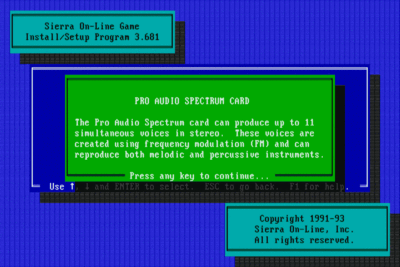firage wrote:I like the sound too. But it is a matter of taste for 1993 and certainly later games. The SB16 and the GUS became available in 92. Games would've definitely considered the Sound Blaster's digital sound in design, but the audio department definitely had better cards involved for most of the process.
I also like the big and "fat" sound of early SBs. Same for early Model 1 Sega Genesises/MegaDrives.
Btw, I once read an article about them. Apparently, the MegaDrive's mono-output gets internally filtered completely differently and
independently from the head phones jack. I don't recall the details, but the mono sound was mixed by a separate chip and the circuit
implied some odd trickery to do the filtering, resulting in this famous, fat sound.
It's a shame I can't find the link to the original post from that guy. 🙁
firage wrote:
The SB16 and the GUS became available in 92. Games would've definitely considered the Sound Blaster's digital sound in design, but the
audio department definitely had better cards involved for most of the process.
I agree. But The SB/SB Pro were still the "gold" standard then. Nobody had an idea how things would went on.
So they continued to optimize their games to sound best on these Sound Blasters, because of their large user base.
Even though game developers had professional audio equipment and could have included higher quality sounds.
I can only imagine what dilemma these games' designers had to face..
There either wasn't just enough space to store separate sets of sounds (in case of floppy releases)
or it was too much of a hassle to go through the whole sound-processing again. (They already were under pressure to meet the dead-line.)
Perhaps it would also have been necessary to modify the games' audio engines for that kind of support, I don't know.
Back in the early to mid 90s, several different PC generations were around next to each others. 286es next to 586es.
I imagine that playback of 16Bit 44KHz audio would have been a bit too much for a 386SX-25,
if it also had to handle graphics at the same time (esp. if audio was streamed in PIO mode).
PhilsComputerLab wrote:Jo22 wrote:
I haven't played a huge number of commercial games when I was a kid, but I think the game "Beneath a Steel Sky"
only supported OPL3 if it detected PAS16 or Adlib Gold. Also, a few DOS-based advergames had built-in PAS support.
But I'm afraid that's about all I can say about this matter. The other cards are just copycats, I believe.
I'm not 100% sure, but I believe Space Quest 4 also gives you Stereo OPL3 with the PAS 16 only. Been a while since I checked the last time though...
Thanks Phil! You're right about special support for the MediaVision cards.
Just checked, my copy of SQ4 does include Stereo FM support for PAS exclusively.
No SB Pro support is mentioned, just normal Adlib and Sound Blaster. And PC-Speaker, MT32/MIDI, of course.
"Time, it seems, doesn't flow. For some it's fast, for some it's slow.
In what to one race is no time at all, another race can rise and fall..." - The Minstrel
//My video channel//
